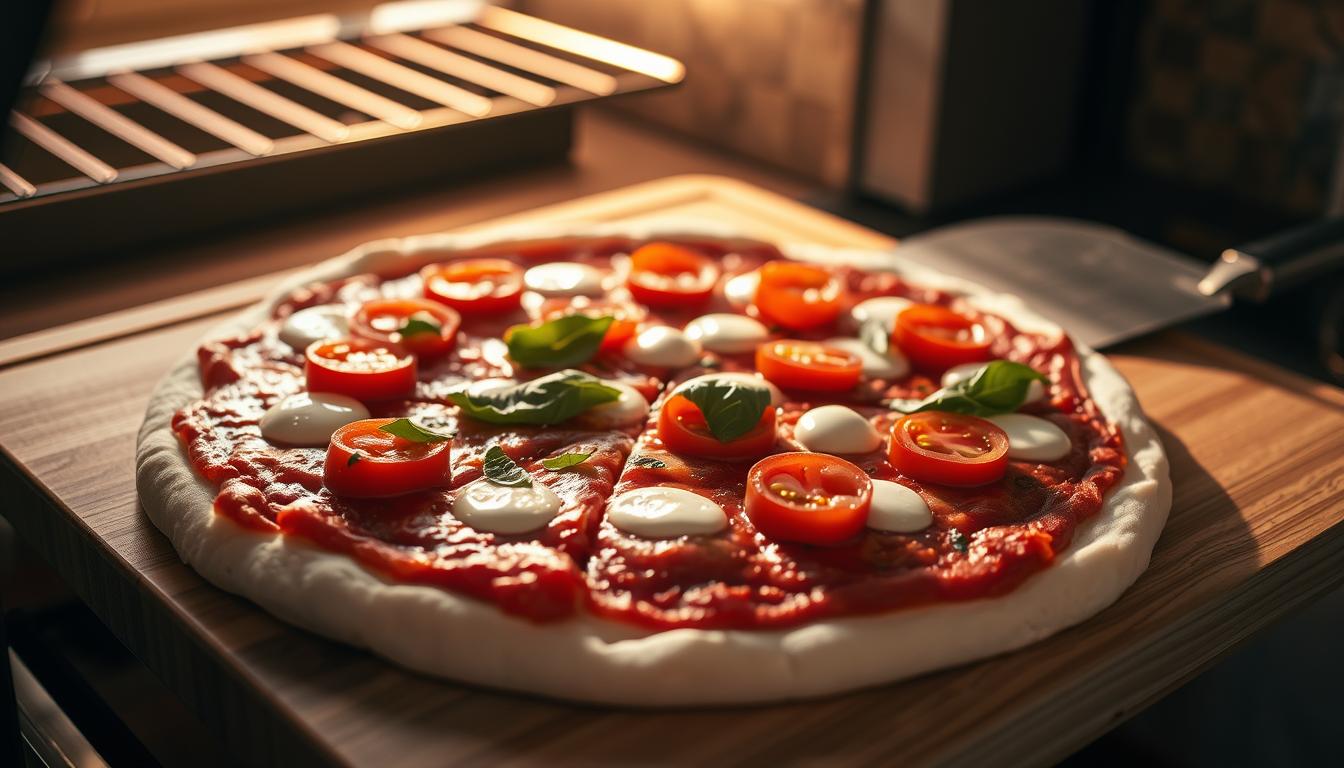Making homemade pizza can be a fun and rewarding experience. With a few simple tips and tricks, you can create a delicious pie that rivals your favorite restaurant.
Whether you’re a seasoned pro or a beginner in the kitchen, cooking pizza at home allows you to customize your toppings and ingredients to your liking. In this article, we’ll share our top tips for making the perfect pizza at home.
Key Takeaways
- Learn the secrets to making a perfect crust
- Discover the best toppings for your homemade pizza
- Understand the importance of temperature and timing
- Get tips for achieving a perfectly melted cheese
- Find out how to customize your pizza to your taste
Introduction to Homemade Pizza
The art of crafting the perfect pizza in the comfort of your own home is a journey worth taking. With homemade pizza, you have the freedom to experiment with a variety of toppings, sauces, and crust styles, making each pizza a reflection of your personal taste.
Why Making Pizza at Home is Worth It
Making pizza at home offers numerous benefits. For one, it allows you to control the ingredients, ensuring that your pizzas are made with the freshest and highest-quality components. Additionally, homemade pizza is a fun and interactive way to spend time with family and friends, creating memories that last a lifetime.
Another significant advantage of homemade pizza is the cost-effectiveness. Making your own pizzas at home can be significantly cheaper than ordering from a restaurant or pizza delivery service, especially for large families or groups.
| Benefits | Description |
|---|---|
| Customization | Control over toppings, sauces, and crust styles |
| Quality Ingredients | Use of fresh and high-quality ingredients |
| Cost-Effective | Cheaper than ordering from restaurants or delivery services |
What You’ll Learn in This Guide
This comprehensive pizza guide is designed to take you through every step of making the perfect homemade pizza. From understanding the fundamentals of pizza dough to mastering different pizza styles and cooking techniques, we’ve got you covered.
You’ll learn about the essential equipment needed for making pizza at home, how to create the perfect pizza sauce, and how to select and apply the right cheese for your pizzas. By the end of this guide, you’ll be well on your way to becoming a homemade pizza expert.
Essential Equipment for Perfect Homemade Pizza
The journey to perfect homemade pizza starts with the right equipment. Having the necessary tools not only makes the process more efficient but also significantly improves the quality of your pizzas.
Pizza Stones and Steel
A pizza stone or steel is crucial for achieving a crispy crust. These tools absorb moisture from the dough and distribute heat evenly, resulting in a perfectly cooked crust.
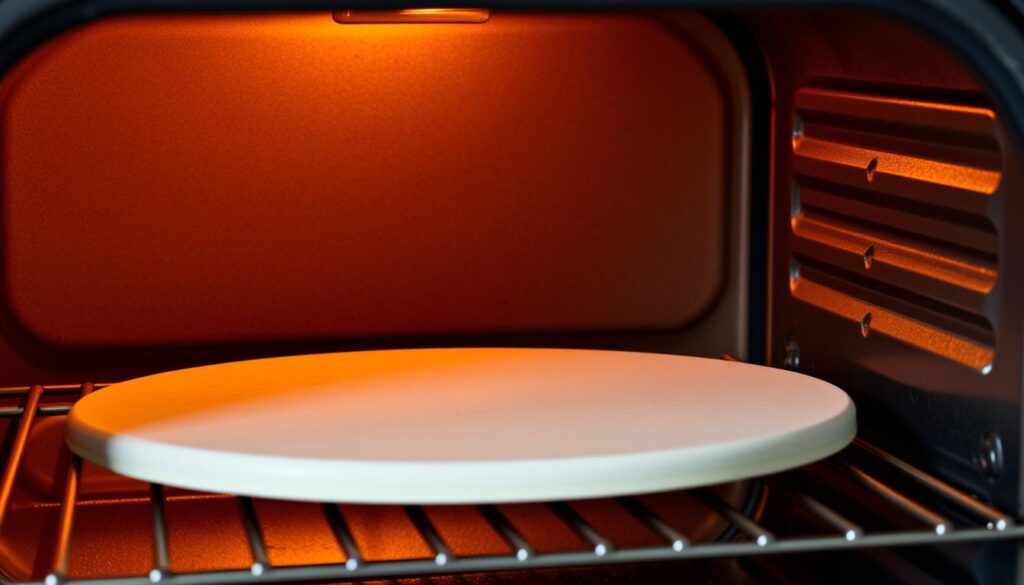
When choosing between a pizza stone and steel, consider your cooking style. Pizza stones are great for absorbing moisture, while steels retain heat exceptionally well.
Pizza Peels and Cutters
A wooden pizza peel is ideal for transferring your pizza to the oven without causing damage to the crust. It’s also easier to slide your pizza onto a preheated stone or steel.
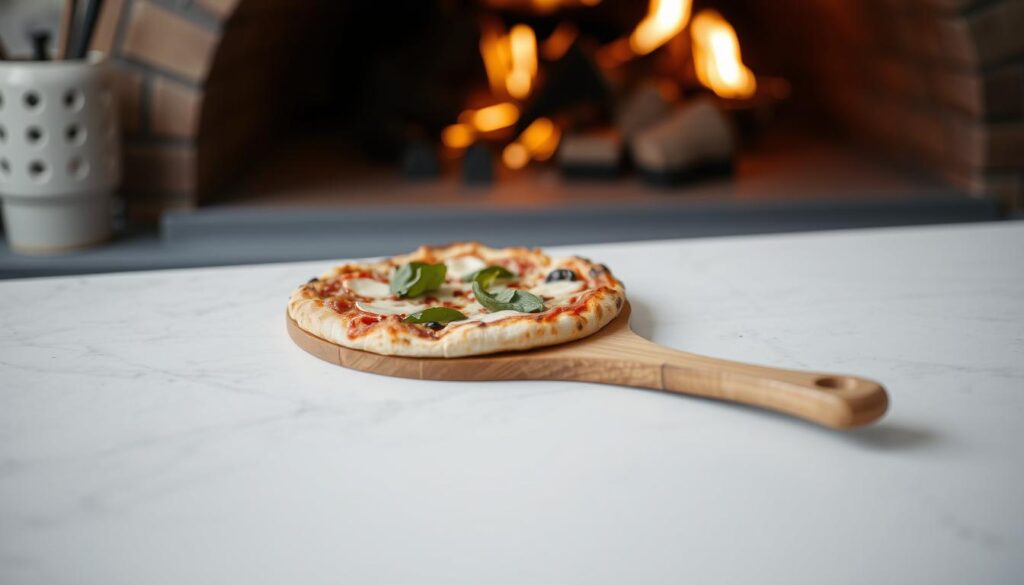
A pizza cutter is another essential tool for serving your pizza. It allows you to cut through the crust and toppings cleanly.
Mixing Bowls and Measuring Tools
Accurate measurements are key to making great pizza dough. Use mixing bowls and measuring tools to ensure your ingredients are properly proportioned.
Oven Thermometers
An accurate oven thermometer ensures that your oven is at the right temperature, which is crucial for cooking pizza. Incorrect temperatures can lead to undercooked or overcooked pizzas.
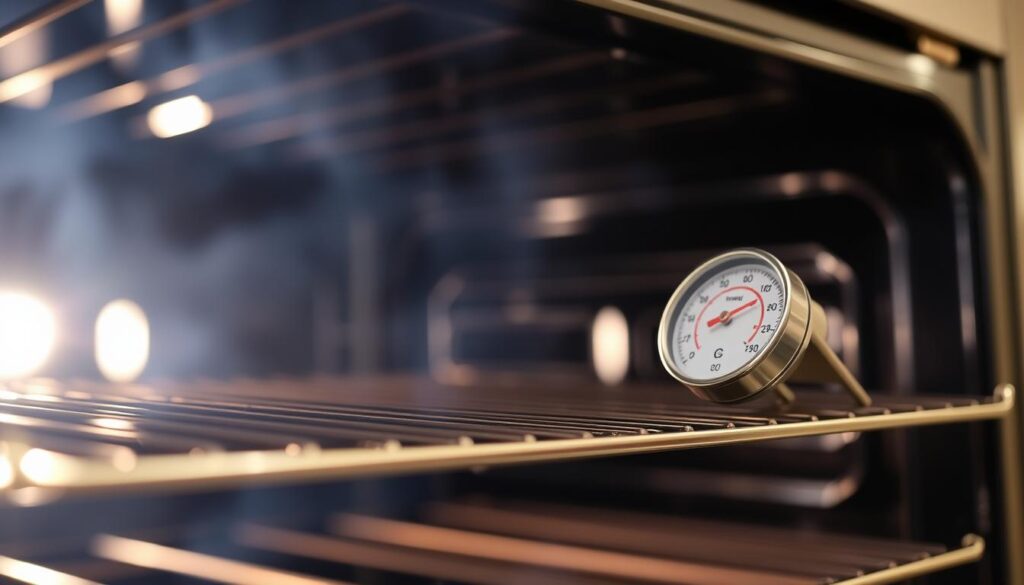
By investing in these essential pieces of equipment, you’ll be well on your way to making perfect homemade pizzas.
Understanding Pizza Dough Fundamentals
The foundation of a great pizza lies in its dough, a simple yet complex mixture that requires understanding and precision. Making great pizza dough involves more than just mixing ingredients together; it’s about creating a dough that is both flavorful and has the right texture.
The Science Behind Perfect Pizza Dough
The science behind pizza dough is rooted in the interaction of its ingredients and the processes they undergo. Yeast fermentation is a critical process that converts sugars into carbon dioxide, causing the dough to rise. This process not only affects the texture but also contributes to the flavor of the crust.
Yeast fermentation is a biochemical process that is influenced by factors such as temperature, yeast quantity, and the availability of sugars. Understanding and controlling these factors is key to achieving the perfect rise and flavor in your pizza dough.
Flour Types and Their Effects on Pizza
The type of flour used in pizza dough significantly affects its quality. Different types of flour have varying protein contents, which impact the dough’s strength and elasticity. For example, Caputo flour is a popular choice among pizza makers due to its high protein content and fine texture.
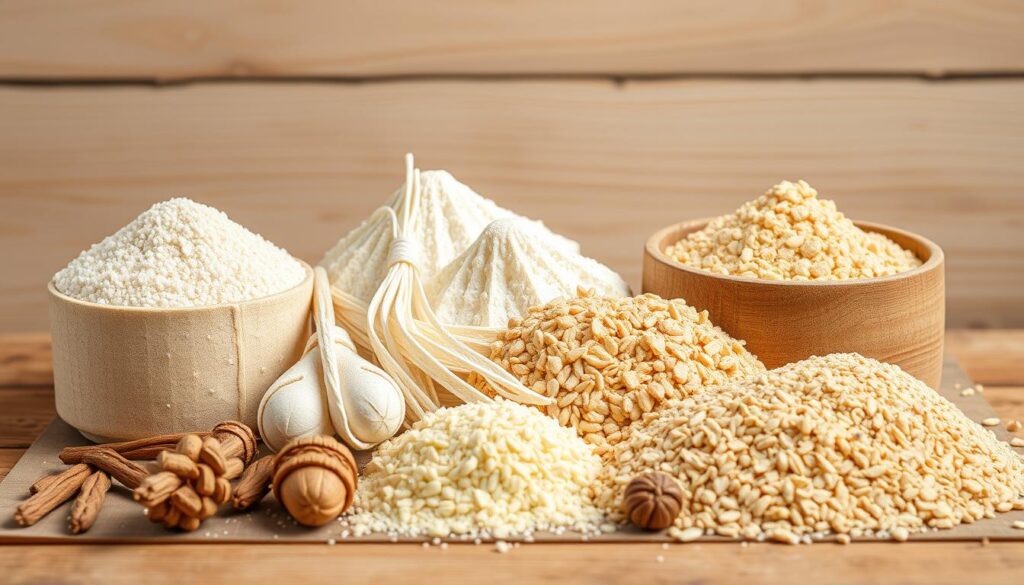
Using the right flour can make a significant difference in the texture and flavor of your pizza crust. It’s worth experimenting with different types to find the one that works best for you.
The Role of Water, Salt, and Yeast
Water, salt, and yeast are the other essential ingredients in pizza dough, each playing a unique role. Water hydrates the flour, allowing the dough to come together and facilitating yeast activity. Salt enhances flavor and controls yeast growth, while yeast is responsible for fermentation.
The balance between these ingredients is crucial. Too much water can make the dough sticky, while too little can make it dry. Similarly, the right amount of salt and yeast is necessary to achieve the perfect balance of flavor and texture.
Step-by-Step Pizza Dough Recipe
With a simple recipe and some basic techniques, you can make delicious pizza dough in the comfort of your own kitchen. Making pizza dough from scratch allows you to control the ingredients and the process, ensuring a crust that’s tailored to your taste preferences.
Ingredients and Measurements
To start, you’ll need a few basic ingredients: 2 cups of warm water, 2 teaspoons of sugar, 1 tablespoon of active dry yeast, 3 1/2 cups of all-purpose flour, 1 teaspoon of salt, and 2 tablespoons of olive oil. Using a digital scale to measure your ingredients accurately is crucial for achieving the right dough consistency.
Mixing and Kneading Techniques
Begin by combining the warm water, sugar, and yeast in a large mixing bowl. Let it sit for 5-10 minutes until the yeast becomes frothy. Then, add the flour, salt, and olive oil, and mix until a shaggy dough forms. Kneading is a critical step that develops the dough’s gluten, giving your crust its chewy texture. Knead the dough on a floured surface for about 10 minutes until it becomes smooth and elastic.
Fermentation and Proofing
After kneading, place the dough in a lightly oiled bowl, cover it with plastic wrap or a damp towel, and let it ferment in a warm, draft-free area. The fermentation process typically takes 1-2 hours, or until the dough has doubled in size. Once fermented, punch down the dough to release any air bubbles, and then let it proof for another 30-60 minutes before shaping it into your pizza crust.
Mastering Different Pizza Styles
Exploring different pizza styles is a culinary adventure that can elevate your homemade pizza game. With various regional styles across the United States and Italy, pizza enthusiasts can experiment with different techniques and ingredients to create unique pizzas.
The diversity in pizza styles is largely due to regional preferences, ingredient availability, and cultural influences. Understanding these differences can help you appreciate the art of pizza making and inspire you to try new recipes.
New York-Style Thin Crust
New York-style pizza is known for its thin crust, crispy bottom, and foldable slices. To achieve this style, use a high-gluten flour and ensure your dough is well-kneaded. The sauce should be light, and the cheese should be a blend that melts well.
Key characteristics:
- Thin crust
- Crispy bottom
- Foldable slices
- Light sauce
- Blend of mozzarella and other cheeses
Chicago Deep Dish
Chicago deep dish pizza is characterized by a thick crust formed into a deep pan and topped with a thick layer of cheese, meats, and vegetables. The crust is flaky and buttery, and the pizza is baked in a deep-dish pan.
Key characteristics:
- Thick crust
- Deep pan
- Thick layers of cheese, meats, and vegetables
- Flaky and buttery crust
Neapolitan Pizza
Neapolitan pizza is a traditional Italian-style pizza that originated in Naples. It is characterized by a soft crust, fresh toppings, and a simple sauce. The pizza is cooked in a wood-fired oven at high temperatures for a short time.
Key characteristics:
- Soft crust
- Fresh toppings
- Simple sauce
- Cooked in a wood-fired oven
Sicilian and Detroit-Style Pan Pizzas
Sicilian and Detroit-style pan pizzas are known for their thick crusts and square shapes. They are baked in a pan and topped with a thick layer of sauce, cheese, and various meats or vegetables.
Key characteristics:
- Thick crust
- Square shape
- Baked in a pan
- Thick layer of sauce and cheese
By mastering these different pizza styles, you can expand your pizza-making repertoire and delight your family and friends with a variety of delicious homemade pizzas.
Creating the Perfect Pizza Sauce
A great pizza starts with a great sauce, and we’re here to guide you through creating one. The sauce is the foundation upon which all other toppings are built, and its flavor can elevate or detract from your pizza experience.
Classic Tomato Sauce Recipe
A traditional tomato sauce is a staple for many pizza styles. To make it, you’ll need canned crushed tomatoes, olive oil, garlic, salt, and herbs like basil and oregano. Start by sautéing minced garlic in olive oil until fragrant, then add the crushed tomatoes, salt, and herbs. Let it simmer for at least 30 minutes to allow the flavors to meld together.
White Sauce Alternatives
Not all pizzas require a tomato-based sauce. A white sauce, made with ingredients like garlic, olive oil, and heavy cream or ricotta cheese, can provide a delicious alternative. This sauce is particularly popular for white pizzas or as a base for certain gourmet pizzas.
Sauce Consistency and Application
The consistency of your pizza sauce is crucial. It should be thick enough to stay on the dough but still be spreadable. To achieve the right consistency, you can simmer the sauce for a longer period or add a little tomato paste. When applying the sauce, use a gentle spreading motion to cover the dough evenly, leaving a small border around the edges without sauce.
- Use a sauce that’s not too runny to prevent a soggy crust.
- Avoid overloading the pizza with sauce, as this can make the crust soggy.
- Experiment with different sauce recipes to find your favorite.
The Art of Cooking Pizza at Home
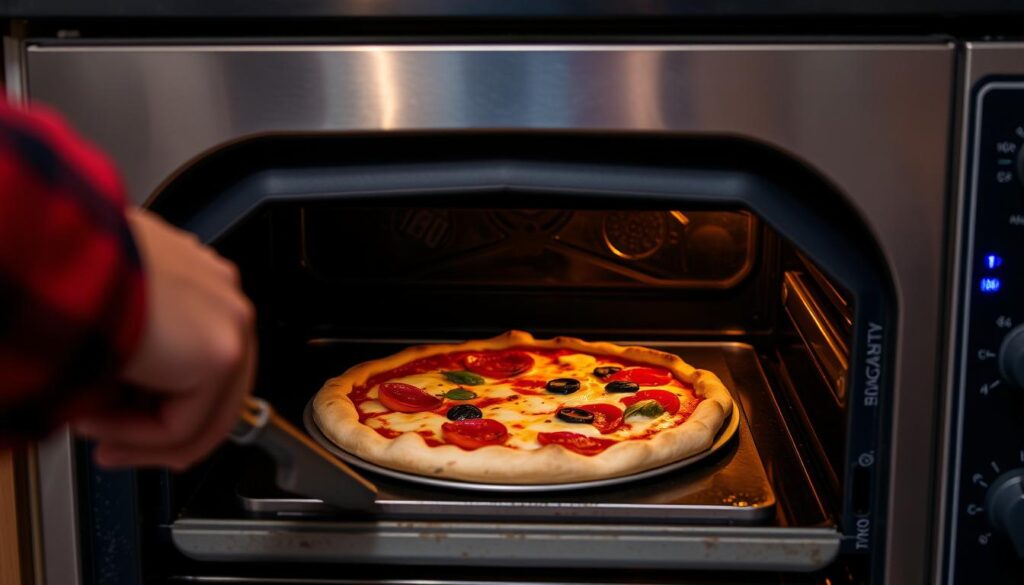
The art of cooking pizza at home involves mastering a few key steps. To achieve a perfectly cooked pizza, it’s essential to understand the importance of oven preparation, transferring the pizza to the oven, and baking times and temperatures.
Oven Preparation and Preheating
Preheating your oven is crucial for cooking pizza. Ensure your oven is preheated to the right temperature, ideally between 450°F to 500°F (230°C to 260°C), to achieve a crispy crust. If you have a pizza stone or steel, place it in the oven during preheating to get it hot.
Transferring Pizza to the Oven
Transferring your pizza to the preheated oven requires care to avoid damaging the crust. Use a pizza peel or a sheet pan sprinkled with cornmeal to slide the pizza onto the hot stone or steel. This helps prevent the dough from sticking.
Baking Times and Temperatures
Baking times can vary based on the temperature and the thickness of your crust. A general guideline is to bake at 450°F (230°C) for 12-15 minutes or until the crust is golden brown. Keep an eye on your pizza to adjust the baking time as needed.
Signs Your Pizza is Perfectly Cooked
A perfectly cooked pizza has a crust that’s golden brown and crispy, with melted cheese and cooked toppings. The edges should be slightly charred, and the crust should be firm to the touch. These signs indicate that your pizza is cooked to perfection.
Cheese Selection and Application
Among the various components of a pizza, cheese stands out as a critical factor that can elevate or detract from the overall flavor and texture. The right cheese can add depth, richness, and a satisfying melt to your pizza.
Mozzarella and Its Varieties
Mozzarella is the most commonly used cheese for pizza due to its excellent melting properties and mild flavor. There are several types of mozzarella, including fresh mozzarella, known for its soft texture and sweet taste, and low-moisture mozzarella, which is preferred for its ability to melt well and provide a creamy texture without making the crust soggy.
For homemade pizza, buffalo mozzarella is a popular choice due to its rich flavor and smooth texture. When selecting mozzarella, consider the moisture content and the flavor profile you desire for your pizza.
Complementary Cheese Combinations
While mozzarella is the foundation, mixing it with other cheeses can enhance the flavor of your pizza. Parmesan adds a salty, nutty flavor, while gorgonzola provides a tangy kick. Experimenting with different combinations, such as mozzarella with provolone or fontina, can also yield delicious results.
How Much Cheese is Too Much?
The amount of cheese to use depends on personal preference and the type of pizza you’re making. A general rule is to use enough cheese to cover the sauce evenly but not so much that it overwhelms the other toppings. Too much cheese can make the crust soggy and overpower the other flavors.
Topping Combinations for Every Palate
Topping combinations are where the magic happens, turning a simple pizza into a culinary masterpiece. The beauty of homemade pizza lies in its customizability, allowing you to experiment with various toppings to suit your taste preferences.
Whether you’re a fan of classic combinations, vegetarian delights, meat-lovers, or gourmet pizzas, there’s a topping combination out there for you. Let’s dive into some popular and inspiring options.
Classic Topping Combinations
Classic topping combinations never go out of style. The Margherita, with its simple yet flavorful combination of tomato sauce, mozzarella, and fresh basil leaves, is a timeless favorite. Another classic is the Pepperoni Pizza, where the spicy kick of pepperoni pairs perfectly with melted mozzarella.
Vegetarian Options
For vegetarians, there are plenty of delicious options. A Roasted Vegetable Pizza with toppings like artichokes, bell peppers, and onions can be a treat. Alternatively, a Mushroom and Truffle combination offers an earthy flavor profile that’s hard to resist.
Meat Lover’s Selections
Meat lovers can rejoice with combinations like Pepperoni, Sausage, and Bacon, which pack a meaty punch. For those looking for something a bit different, a Chicken BBQ Pizza with grilled chicken, BBQ sauce, and red onions is a great choice.
Gourmet and Unexpected Pairings
For the adventurous, gourmet topping combinations can elevate your pizza experience. Consider a Fig and Prosciutto pizza, where the sweetness of figs pairs with the salty crispness of prosciutto. Another unique combination is Pear and Gorgonzola, offering a sweet and tangy flavor profile.
To help you visualize some of these combinations, here’s a table summarizing a few topping combinations:
| Topping Combination | Description |
|---|---|
| Margherita | Tomato sauce, mozzarella, fresh basil |
| Meat Lover’s | Pepperoni, sausage, bacon |
| Roasted Vegetables | Artichokes, bell peppers, onions |
| Fig and Prosciutto | Figs, prosciutto, arugula |
Cooking Pizza Without a Traditional Oven
You don’t need a conventional oven to make great pizza; there are several alternatives worth exploring. Whether you’re looking to try a new cooking method or don’t have access to a traditional oven, there are various ways to achieve a delicious homemade pizza.
Grilling Pizza Outdoors
Grilling pizza outdoors can add a smoky flavor that enhances the overall taste. To grill pizza, preheat your grill to a high temperature, shape your dough into a circle or rectangle, and cook for 2-3 minutes on each side. Top with your favorite ingredients during the last minute of cooking.
Using a Pizza Oven Attachment
A pizza oven attachment can be a great investment for those who want to achieve a wood-fired taste at home. These attachments can be used on grills and provide a hot, enclosed environment for cooking pizzas. They are relatively easy to use and clean.
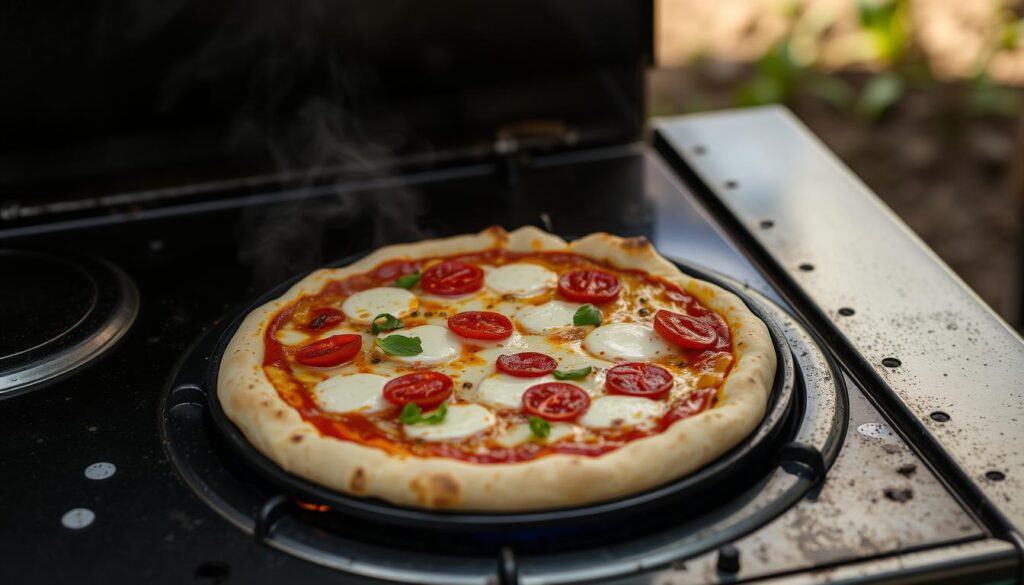
Stovetop Pizza Methods
Cooking pizza on the stovetop is another viable option. Use a skillet or pizza stone in a pan over medium-high heat. Cook the dough for a few minutes on the first side, then flip and top with ingredients. Cover the pan to melt the cheese and cook until the crust is golden.
Troubleshooting Common Pizza Problems
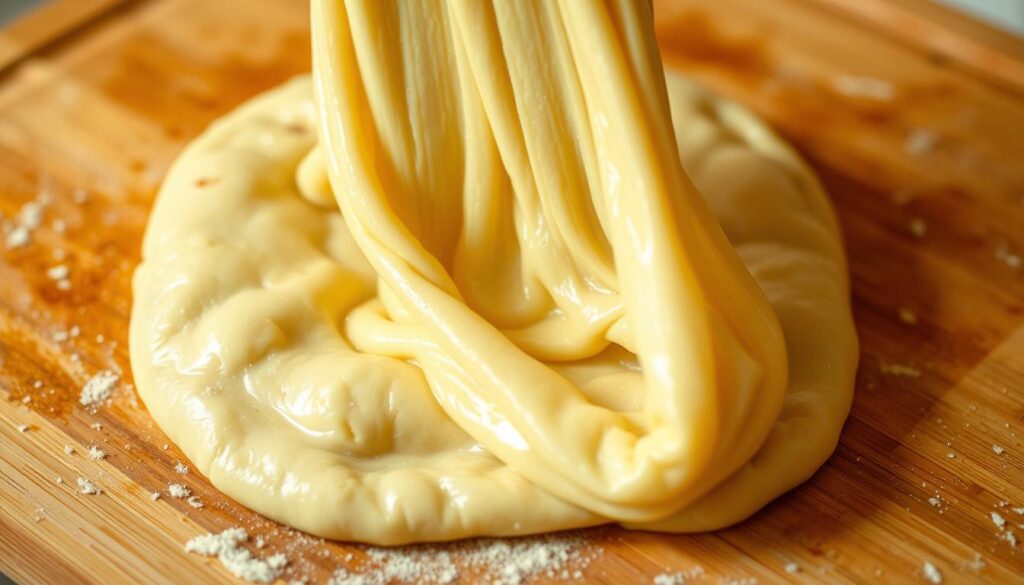
From sticky dough to burnt crusts, several issues can arise when making pizza at home. Understanding how to address these problems is crucial for achieving a perfect pie every time.
Dealing with Sticky Dough
Sticky dough is a common issue that can be frustrating to handle. To prevent this, ensure your work surface is floured adequately, and consider using a pizza peel sprinkled with cornmeal to help the dough slide off easily. If the dough is still sticky, try refrigerating it for about 30 minutes to firm it up before shaping.
Preventing Soggy Centers
A soggy center can ruin an otherwise perfect pizza. To avoid this, make sure your oven is preheated to a high temperature, and use a pizza stone or steel to cook the crust evenly. Additionally, avoid overloading your pizza with toppings, as this can release too much moisture during baking. Balance is key when it comes to toppings.
Fixing Burnt Crusts
Burnt crusts are often a result of an oven that’s too hot or a pizza cooked for too long. To fix this, keep a close eye on your pizza while it’s baking, and consider reducing the oven temperature slightly. If you notice the crust browning too quickly, you can tent the pizza with foil to prevent further burning.
Addressing Uneven Cooking
Uneven cooking can occur due to an improperly preheated oven or a pizza stone that’s not hot enough. To combat this, ensure your oven and stone are preheated for at least 30 minutes before baking. Rotating the pizza halfway through the cooking time can also help achieve a more even cook.
By understanding and addressing these common pizza problems, you can significantly improve your homemade pizza-making skills and enjoy a more consistent and delicious result.
Advanced Techniques for Pizza Perfection
To elevate your homemade pizza game, it’s essential to master advanced techniques. These methods can significantly improve the quality and authenticity of your pizzas, making them comparable to those from professional pizzerias.
Long Fermentation Methods
Long fermentation is a technique used by professional pizzaiolos to develop complex flavors in the dough. This process involves allowing the dough to ferment for an extended period, typically between 24 to 72 hours. The longer fermentation time breaks down the starches in the dough, resulting in a more digestible and flavorful crust.
Benefits of Long Fermentation:
- Enhanced flavor profile
- Improved dough texture
- Better digestibility
Stretching Dough Like a Pro
Stretching dough is an art that requires practice and patience. To stretch dough like a pro, start by gently pressing down on the dough with your fingertips, working from the center outwards. Rotate the dough as you stretch it to maintain an even thickness and prevent tears.
Tips for Stretching Dough:
- Use a light touch to avoid tearing the dough
- Rotate the dough frequently for even stretching
- Don’t overwork the dough
Creating the Perfect Crust Edge
The crust edge, or cornicione, is a crucial element of a well-made pizza. To create a perfect crust edge, ensure that your dough is properly proofed and that you have a hot oven. The edge should be crispy and slightly charred, adding texture and flavor to the pizza.
Techniques for a Perfect Crust Edge:
- Use a pizza stone or steel to achieve a crispy crust
- Preheat your oven to its highest temperature
- Don’t overload the pizza with toppings
Storing and Reheating Leftover Pizza
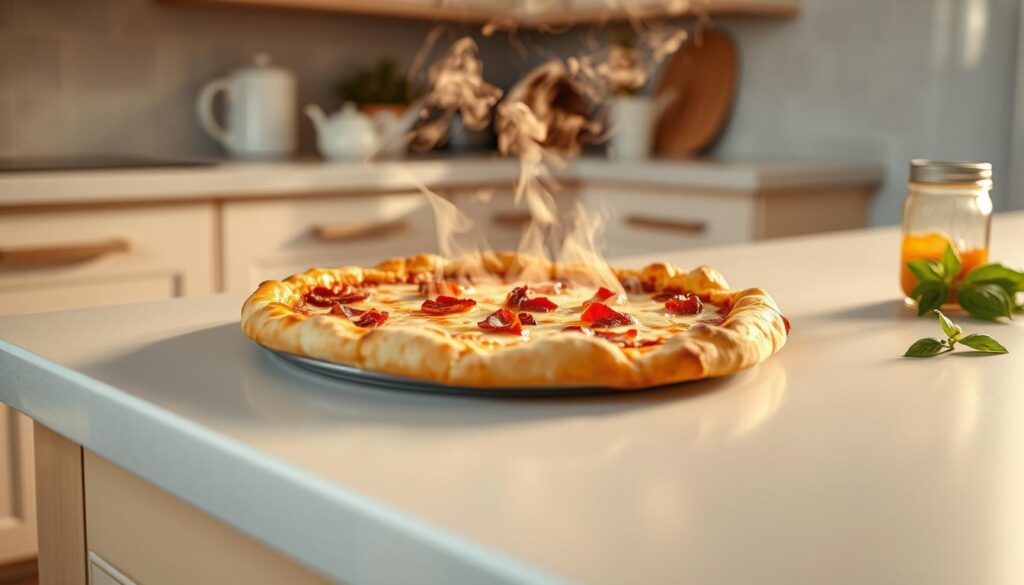
Storing and reheating leftover pizza is an art that can preserve its original flavor and texture. Whether you’re dealing with a few slices or a whole pie, knowing the right techniques can make all the difference.
Proper Storage Methods
To keep leftover pizza fresh, it’s essential to store it correctly. Here are some tips:
- Cool the pizza to room temperature before storing to prevent moisture buildup.
- Use an airtight container or wrap slices individually in plastic wrap or aluminum foil.
- Store in the refrigerator at a temperature below 40°F (4°C).
Freezing is also an option for longer storage. Place the pizza in a single layer on a baking sheet, freeze until solid, and then transfer to a freezer-safe bag or container. Frozen pizza can be stored for up to 3 months.
Best Reheating Techniques
Reheating pizza properly is crucial to maintaining its texture and flavor. Here are some methods:
- Oven Reheating: Preheat your oven to 425°F (220°C). Place pizza slices on a baking sheet and bake for 10-12 minutes, or until crispy.
- Skillet Reheating: Heat a skillet over medium heat. Place a slice in the skillet, cover, and cook for 2-3 minutes or until the crust is crispy and cheese is melted.
- Microwave Reheating: For a quick reheat, use the microwave. Place a slice on a microwave-safe plate and heat for 20-30 seconds. Be cautious as the crust may become soggy.
By following these storage and reheating tips, you can enjoy your leftover pizza with minimal loss of quality.
Conclusion: Your Journey to Pizza Mastery
Embarking on a homemade pizza journey can be a rewarding experience, and with the right techniques and practice, achieving pizza mastery is within reach. By understanding the fundamentals of pizza dough, mastering different pizza styles, and experimenting with various toppings and sauces, you can create delicious pizzas that rival those from your favorite pizzerias.
As you continue on your homemade pizza journey, remember that practice makes perfect. Don’t be discouraged if your first attempts don’t turn out as expected. Keep refining your techniques, and you’ll soon be creating pizzas that impress family and friends.
With the knowledge and skills gained from this guide, you’re well on your way to pizza mastery. So, keep exploring new recipes, ingredients, and cooking methods to take your homemade pizzas to the next level.
FAQ
What is the best type of flour to use for making pizza dough?
The best flour for pizza dough is often considered to be Caputo or All-Purpose flour with a high protein content, such as King Arthur Flour. These flours produce a strong dough that can hold its shape and yield a crispy crust.
How do I achieve a crispy crust when cooking pizza at home?
To achieve a crispy crust, preheat your oven to its highest temperature setting, typically around 500-550°F, with a pizza stone or steel inside. Use a thin layer of sauce and toppings, and cook the pizza for a shorter amount of time, around 10-12 minutes.
What is the ideal temperature for cooking pizza?
The ideal temperature for cooking pizza varies depending on the style, but a general rule of thumb is to cook at a high temperature, typically between 450-550°F, to achieve a crispy crust and well-cooked toppings.
How often should I knead pizza dough?
Kneading pizza dough for around 5-10 minutes, either by hand or using a stand mixer, helps develop the gluten and achieve a smooth, elastic texture. Over-kneading can lead to a tough crust.
Can I make pizza without a pizza stone or steel?
While a pizza stone or steel can help achieve a crispy crust, it’s not necessary. You can still make great pizza on a baking sheet or cast-iron skillet, although the crust may not be as crispy.
What are some common mistakes to avoid when making homemade pizza?
Common mistakes include overloading with toppings, not preheating the oven or stone, using too much sauce, and not cooking the crust long enough. Avoiding these mistakes can help you achieve a perfectly cooked pizza.
How do I store leftover pizza to keep it fresh?
To store leftover pizza, cool it to room temperature, then wrap it tightly in plastic wrap or aluminum foil and refrigerate or freeze. Reheat in the oven or toaster oven to restore crispiness.
What are some alternative cooking methods for pizza if I don’t have a traditional oven?
Alternative cooking methods include grilling, using a pizza oven attachment, or cooking on the stovetop in a skillet. These methods can produce a crispy crust and well-cooked toppings with a bit of practice.
How do I prevent a soggy center in my pizza?
To prevent a soggy center, ensure the crust is cooked long enough, use a moderate amount of sauce and toppings, and avoid overloading with wet ingredients. Pre-baking the crust can also help.
What is the best type of mozzarella cheese for homemade pizza?
Fresh mozzarella or whole-milk mozzarella is ideal for homemade pizza due to its creamy texture and mild flavor. Look for high-quality, artisanal mozzarella for the best results.
